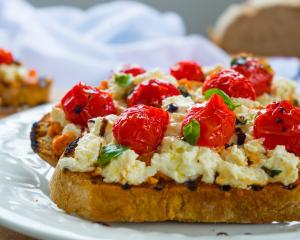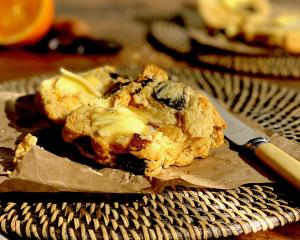Food is at the heart of all cultures. It is more than just sustenance. It is a universal expression of aroha and whānau and a bridge between past and present. It is the recipe card smudged with love, and the secret ingredient whispered from one generation to the next.

While many of us are familiar with the traditional Māori dishes of hangi, boil up and rewena paraoa (Māori bread), my quest takes me beyond the surface, towards the heart of a kuia’s kitchen and ultimately towards a deeper understanding of kai in the Māori world.
While living and working in the Netherlands, my husband and I formed a close bond with an Italian colleague, Valerio. We were lucky enough to be invited to his family’s crib in Calabria for several summers. Embraced by their warm hospitality, it was during that time my culinary senses were ignited. Nonna was always there, a quiet presence who would materialise out of thin air, bearing a plate laden with crescent-shaped pastries stuffed with prosciutto and provolone. These delicious morsels were called ‘‘panzerotti’’, and we couldn’t get enough of them.
Our host’s entertaining debates added to the charm of our introduction to Italian culture; Evelina hailed from Rome, while Valerio was a proud Calabrian. Their contrasting views on Italian gastronomy, ingredients and preparation methods provided endless entertainment. Naturally, my queries about recipes sparked spirited exchanges, leaving me more confused than enlightened about how to replicate the contentious dish.
Following our first trip to Calabria, upon our return to The Hague, we extended a dinner invitation to Valerio, as Evelina was away. That night, I presented my then self-proclaimed ‘‘signature’’ lasagne — a choice I would later come to question. At the end of the meal, Valerio remarked: “Colleen, that is indeed delicious, but it is not lasagne! Allow me to introduce you to my rendition of lasagne!” True to his word, he arrived bearing his homemade lasagne the following week. At first glance, I admit to having felt slightly underwhelmed by its appearance — dotted with flecks of butter on the surface, where was the luxurious cascade of melting cheese?
The transformation from oven to table did not disappoint. The pure simplicity of his dish, steeped in familial traditions, made it, most definitely, the best lasagne I have eaten to this day. Even armed with identical ingredients and instructions, I couldn’t emulate his version.
Ultimately, these experiences highlight how food connects us, no matter where we are. Whether in Aotearoa or Italy, the love and family values woven into each dish remind us of shared culinary heritage.
The dishes included in this article are inspired by ‘‘comfort’’ and ‘‘casual entertaining’’ and the need to rekindle the joy of hosting after the winter hibernation. Having traversed the shortest day of the year, a glimmer of hope is on the horizon. We are not quite at salad weather yet, and the cost of groceries can still be a shock, so these dishes are designed to make the most of seasonal produce and pantry staples. The main dish is influenced by my love for Italian cuisine and while my attempts to recreate Valerio’s ‘‘perfect’’ lasagne might fall short, I feel this dish captures the essence of those flavours. The beauty lies in their simplicity and preparation in advance, so you can enjoy conversations without being confined to the kitchen for hours.
In our household, we have different views on how much food to serve before dinner. For casual entertaining, I like to keep things simple, leaving enough space for the main course and dessert. With avocados now back in supermarkets and affordable, here is a quick dip idea. Greek yoghurt adds a nice tang and creaminess. Enjoy it as part of a platter or on its own with a selection of raw veggies and corn chips.
To make your lamb stretch, consider getting two to three larger shanks or drums. You can serve the meat without the bone. I used two shanks in this recipe, and there was plenty of meat to serve four people generously.
If you’ve got leftover Italian chickpeas, they are great for a Sunday brunch on toasted sourdough and topped with a poached egg.
When it comes to Tarte tatin, the true magic lies within its pastry. After a few attempts in the past, I couldn’t quite understand the hype - until I made the pastry. It is so simple yet completely transformative and presents beautifully on a plate.
instagram @mrscolls

Apple tarte tatin
Makes 1×28cm tart
For the rough puff pastry
200g plain flour
200g chilled unsalted butter
About 80ml water (adjust as needed)
¼ tsp salt
Method
Start by cutting the butter into small(ish) cubes.
In a mixing bowl, combine the flour and salt. Add the cold butter cubes to the flour, tossing to coat.
Gradually add the water and gently mix until the dough starts to come together. The pastry might seem a bit crumbly but just form into a a rough rectangle, wrap in plastic wrap and rest in the fridge for at least 30 minutes. Don’t overwork it.
Place the dough on a lightly floured surface and roll it out into a rectangle, about three times as long as it is wide, shortest edge facing you.
Fold the bottom third of the rectangle over the middle third, then fold the top third over that, like you are folding a letter. Turn 90 degrees. This is the first “fold” or “turn”. Rest in fridge for at least 30 minutes. Repeat this process three times, chilling for at least an hour (or overnight) before using.
For the tarte tatin
175g caster sugar
130g unsalted butter
1 vanilla bean, split lengthways
About 6 medium Granny Smith apples, peeled, cored and quartered
1 batch of rough puff pastry
Method
Preheat the oven to 200°C.
Place the sugar in the base of a 28cm (measured across the top of pan) ovenproof frying pan over a low to medium heat. Do not be tempted to stir the mixture as it could crystallise. When the sugar has melted and turned a deep caramel colour, add the water and whisk, bring it back to the boil. Add the butter, whisk and scrape in the vanilla seeds and add empty pod, then turn off the heat.
Place the apples on top of the caramel, cut side up. You may need to trim a few to allow them to fit snugly in the pan.
Roll your pastry out until 1cm thick and cut a 28cm disc (same size as pan) to fit over the top of the apples pinching the edges with your fingers to seal. Cut a whole in the centre to allow steam to escape.
Bake in the oven for 45 minutes until a deep golden brown. You may want to check at 40 minutes depending on how hot your oven runs. Allow it to sit for 15 minutes before inverting on to a serving plate. Serve with vanilla bean ice-cream.

Braised lamb with Italian chickpeas and gremolata
Serves 4
Ingredients
¼ cup flour
2 to 4 lamb shanks depending on size and if you are serving on or off bone; (see notes)
1 large onion
1 large carrot
2 celery stalks
1 bulb garlic, cut in half
1 bay leaf
1 stalk each of rosemary and thyme
1 Tbsp tomato paste
2 cups chicken stock (or wine, white or red, if preferred)
1 tin whole peeled tomatoes
Olive oil
Flaky salt and freshly ground pepper
Method
Preheat oven to 150°C.
Season the lamb shanks with flaky salt and freshly ground pepper. Coat them in the flour, reserving any excess flour to add later with the tomato paste.
Heat a good tablespoon of olive oil in a Dutch oven or deep roasting dish (large enough to snugly fit the lamb) over medium heat. Brown the lamb shanks on all sides then set them aside.
Add onions, celery and carrot to the pan with a bit more oil if needed. Cook gently until softened, about 6 minutes.
Add the garlic, bay leaf, herbs, tomato paste and any excess flour. Fry for another 2 minutes before adding the chicken stock (or wine) and tomatoes. Slightly break up the tomatoes in the pan.
Return the lamb shanks to the pan with all the other ingredients. Ensure the meat is almost covered with liquid. If not, add another tin of tomatoes, more stock or wine. Cover tightly with a lid or foil and place in the preheated oven.
Check the shanks after 2½ hours. They should be tender and almost falling off the bone. Depending on shank size and oven performance, they might take up to 4 hours.
Once ready, remove the shanks from the sauce and set them aside. You can strain and reduce the sauce, or leave the vegetables in (squeeze the garlic out of skin into the sauce and remove herb stalks). Place the sauce back on heat and gently simmer until slightly thickened and intensified in flavour. Adjust with a teaspoon of sugar, salt and pepper to taste.
Serve the lamb atop the Italian chickpeas, with the reduced sauce, and garnished with gremolata.
Italian chickpeas
1 Tbsp olive oil
2 tins chickpeas, drained
1 large onion, finely diced
1 large celery stalk, halved vertically and sliced
1 large carrot, peeled and finely diced (onion, celery and carrot roughly the same size)
2 cloves garlic, finely chopped
1 Tbsp dried oregano
½ tsp dried chilli flakes
2 Tbsp tomato paste
1 cup of chicken stock
2 tins of baby roma tomatoes or 1 tin plus 1 cup of reserved lamb jus
Salt and pepper, to taste
Method
Heat olive oil in a pan and gently saute the onion, celery, carrot and garlic until soft.
Add the chickpeas and herbs, and cook for an additional minute.
Stir in the tomato paste and cook for a further minute.
Pour in the chicken stock, followed by the tinned tomatoes.
Simmer gently until the liquid reduces and the sauce thickens, about 30-40 minutes.
Season with salt and pepper to taste
Gremolata
1 cup flat-leaf Italian parsley, roughly chopped
½ cup of olives (I used green, pitted, marinated with preserved lemons and added the preserved lemons to the mix), finely chopped
2 Tbsp of capers, roughly chopped
1 large garlic clove, finely minced
Zest of one lemon (if not using preserved lemon)
½ cup good-quality extra virgin olive oil
Salt and pepper to taste
Method
In a small bowl, combine all the ingredients.
Taste and adjust the seasoning as needed.
If you prefer a thinner consistency, add a bit more oil or lemon juice.

Avocado dip
¼ cup red onion, chopped as finely as possible
1 garlic clove, crushed and finely chopped
2 Tbsp Greek yoghurt
3 Tbsp or a bunch of coriander leaves, chopped
1-2 limes juiced (depending on how juicy)
3 avocados, halved, pitted and roughly mashed
Flaky sea salt and cracked black pepper to taste
Method
Combine all the ingredients in a bowl and adjust the seasoning to taste.











